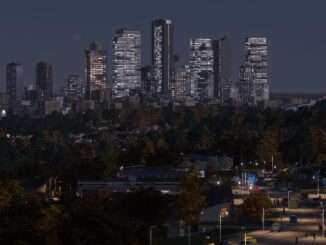
How to understand the economy and production chains.
Contents
Intoduction
Cities: Skylines 2 introduces changes to the economy that require players to manage and balance it more carefully.
This guide will help you navigate this new economic challenge and provide strategies for success.
Commercial Zone Saturation

In this screenshot, we encounter a saturated commercial area with too many furniture stores. This situation can occur if you recklessly zone commercial lots all at once. These stores may have spawned due to a heavy local logging industry.
Since wood doesn’t need to be imported, the simulation evaluated that furniture stores would see the most profit, and spawned a bunch of them.
Understanding the Production Chain
To gain control over your city’s economy, it’s essential to understand how production works.
For example, if you have an excess of something, check the production chain to see if you can convert it into a more valuable resource.
For example, I produce a surplus of grain:

But if I click on grain, I can see that grain can turn into petrol:

But if I scroll down to look at petrol, it seems I import a lot of it:

So ideally, I should zone new industry and/or demolish companies until I find one that creates petrol from grain. That business should then thrive in my city.
Exporting raw materials like grain may not be profitable. However, setting up a supply chain (like above) to produce higher-value products can benefit your city’s companies and help them level up.
A Hands-Off Approach
You can influence which industries appear in your city by using taxation and subsidies effectively. For instance, if you want to promote the automobile industry, you can subsidize automobiles to attract those companies to your city.

This will encourage automobile companies to spawn in your new developments, which will, in turn, create a domino effect, boosting demand for automobile manufacturing components. Eventually, you can tax automobiles once the resulting industries have been established.
To expedite the domino effect, you’d probably want to look at what materials are necessary for automobile production, and subsidize all of those as well.
Addressing the “Not Enough Customers” Issue
I have this supermarket that complains about not enough customers.
It sells “Food” but I also have a lot of fast food companies nearby. Fast food is a different resource, but perhaps it’s competing with our supermarket.

But if I check the production tab, I see that food can be consumed by more than just cim consumers, it can also be used by other retail outlets, and converted into “Meals” or “Lodging”:

I have two electronic shops next to this supermarket, so lets demolish one until I get a company that produces Meals or Lodging.
There we go! This Donut Shop will utilize food and sell meals.

Now, the big question… will it solve our problem?
And…
After like 20 seconds, the supermarket no longer complains!

Conclusion
Managing your city’s economy in Cities: Skylines 2 requires careful planning and attention to detail. Use taxation, subsidies, and the production chain effectively to create a thriving and balanced city.
Remember that profit drives all businesses, and they will reinvest profits to level up the building, which creates less burden on water/electric, higher salaries for employees, and requires higher education positions to be filled. Travel costs eat into profits now, so you ideally never want to import or export as shipping costs a lot.





Be the first to comment